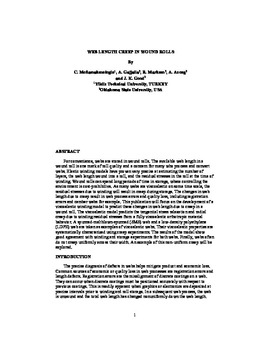| dc.contributor.author | Mollamahmutoglu, C. | |
| dc.contributor.author | Gajjalla, A. | |
| dc.contributor.author | Markum, Ron E. | |
| dc.contributor.author | Azoug, Aurelie | |
| dc.contributor.author | Good, J. K. | |
| dc.contributor.other | International Conference on Web Handling (2019) | |
| dc.date.accessioned | 2019-06-04T16:16:34Z | |
| dc.date.available | 2019-06-04T16:16:34Z | |
| dc.date.issued | 2019-06 | |
| dc.identifier | oksd_icwh_2019_GoodGajjalla2 | |
| dc.identifier.citation | Mollamahmutoglu, C., Gajjalla, A., Markum, R. E., Azoug, A., & Good, J. K. (2019, June). Web length creep in wound rolls. Paper presented at the Fifteenth International Conference on Web Handling (IWEB), Stillwater, OK. | |
| dc.identifier.uri | https://hdl.handle.net/11244/320258 | |
| dc.description.abstract | For convenience, webs are stored in wound rolls. The available web length in a wound roll is one mark of roll quality and a concern for many who process and convert webs. Elastic winding models have proven very precise at estimating the number of layers, the web length wound into a roll, and the residual stresses in the roll at the time of winding. Wound rolls can spend long periods of time in storage, where controlling the environment is cost-prohibitive. As many webs are viscoelastic on some time scale, the residual stresses due to winding will result in creep during storage. The changes in web length due to creep result in web process errors and quality loss, including registration errors and camber webs for example. This publication will focus on the development of a viscoelastic winding model to predict these changes in web length due to creep in a wound roll. The viscoelastic model predicts the tangential stress relaxation and radial creep due to winding residual stresses from a fully viscoelastic orthotropic material behavior. A spunned-meltblown-spunned (SMS) web and a low-density polyethylene (LDPE) web are taken as examples of viscoelastic webs. Their viscoelastic properties are systematically characterized using creep experiments. The results of the model show good agreement with winding and storage experiments for both webs. Finally, webs often do not creep uniformly across their width. An example of this non-uniform creep will be explored. | |
| dc.format | application/pdf | |
| dc.language | en_US | |
| dc.publisher | Oklahoma State University | |
| dc.rights | In the Oklahoma State University Library's institutional repository this paper is made available through the open access principles and the terms of agreement/consent between the author(s) and the publisher. The permission policy on the use, reproduction or distribution of the article falls under fair use for educational, scholarship, and research purposes. Contact Digital Resources and Discovery Services at lib-dls@okstate.edu or 405-744-9161 for further information. | |
| dc.title | Web length creep in wound rolls | |
| osu.filename | oksd_icwh_2019_GoodGajjalla2.pdf | |
| dc.description.department | Mechanical and Aerospace Engineering | |
| dc.type.genre | Conference proceedings | |
| dc.type.material | Text | |
